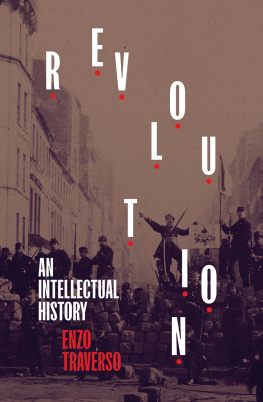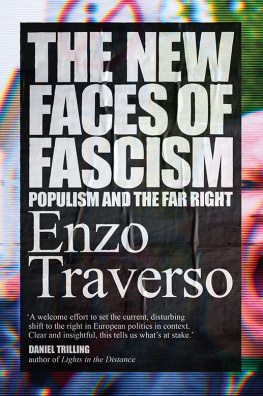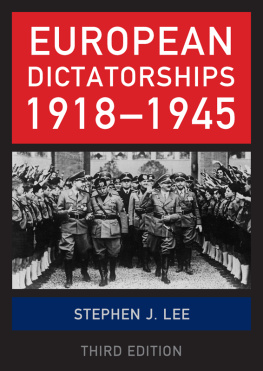FIRE AND BLOOD
The European Civil War 19141945
Enzo Traverso
Translated by David Fernbach

This English-language edition first published by Verso 2016
Translation David Fernbach 2016
Originally published as A feu et sang: De la guerre civile europenne 19141945
Editions Stock 2007
All rights reserved
The moral rights of the author have been asserted
1 3 5 7 9 10 8 6 4 2
Verso
UK: 6 Meard Street, London W1F 0EG
US: 20 Jay Street, Suite 1010, Brooklyn, NY 11201
www.versobooks.com
Verso is the imprint of New Left Books
ISBN-13: 978-1-78478-133-0 (HB)
eISBN-13: 978-1-78478-134-7 (US)
eISBN-13: 978-1-78478-135-4 (UK)
British Library Cataloguing in Publication Data
A catalogue record for this book is available from the British Library
Library of Congress Cataloging-in-Publication Data
A catalog record for this book is available from the Library of Congress
Typeset in Garamond Pro by MJ & N Gavan, Truro, Cornwall
Printed in the US by Maple Press
To my mother, who was twenty at the time of Liberation
Contents
M y thanks first of all to Franois Guedj and Valeria Galimi, editors of the collective work on Le XXe Sicle des guerres (Paris: ditions de lAtelier, 2004), which contained my first discussion on the idea of European civil war and gave rise to a study day at the University of Toulouse in March 2005. Several sections of this book were presented and discussed over the next three years at lectures, colloquia, seminars, and sometimes courses that I gave as guest professor at universities in the United States and Latin America, as well as in Europe. I would like to thank the colleagues and friends who offered me these opportunities for debate, as well as the researchers and students who took part in them, starting with those from the masters programme in political science at my own university, Amiens. Though unable to mention everyone, I would particularly like to remember Angelo Ventrone and Luca Baldissara from the universities of Macerata and Pisa in Italy; Nicols Snchez Dur and Ismael Saz from the University of Valencia, as well as Francisco Cobo Remero of the UNIA of Baeza, in Spain; Gilbert Achcar, when he was attached to the Centre Marc-Bloch, and Elfi Mller, organizer of the Jour Fixe lectures, in Berlin; Federico Finchelstein, Tim Campbell and Dominick LaCapra of Cornell University at Ithaca, NY; Ruth Ben-Ghiat of New York University; Patricia Flier and Jos Sazbon of the Universidad Nacional de La Plata, in Argentina; and Esther Cohen of UNAM, in Mexico City. I assure them all of my gratitude and friendship. Besides seminars and conferences, this book owes much to the reflections on comparative violence in the contemporary world that I have been conducting for several years now together with Marina Cattaruzza, Dan Diner, Marcello Flores and Simon Levis Sullam. Finally, I would like to thank Nicole Lapierre, attentive reader and critic of my manuscript, for having accepted it for her fine series with ditions Stock.
Paris, October 2006
The English edition of this book is released almost nine years after the original French, and follows the German, Greek, Italian and Spanish translations. It only includes a few marginal corrections and additions, mostly bibliographical updates. I would like to thank David Fernbach for his excellent translation and Sebastian Budgen for enabling this book to join the Verso catalogue.
Paris/Ithaca, NY, January 2015
C ertain images of the twentieth century are inscribed in our memory as visual references, icons of the past that sum up its meaning and retain its taste. Everyone knows Andy Warhols Coca-Cola bottles, the figure of astronaut Neil Armstrong stepping onto the Moon, and the artificial happiness of Marilyn Monroes smiles. When we think of the decades stretching from the First World War to the Second, however, everything darkens. We see the trenches, the rail tracks leading into the camp of Auschwitz-Birkenau under the snow of the Polish winter, the mushroom cloud of Hiroshima. The age of extremes has produced its imaginary of horror, with a whole world of suffering behind it, but also social experiences, shared cultures, ideas and struggles that the present book aims to explore by way of the concept of a European civil war. This term has been used by several commentators and interpreters, from the interwar years on, even if the only writer to have developed it systematically and in a highly debatable manner is Ernst Nolte. If I adopt it here, it is to try and grasp the meaning of an age of wars and revolutions in which the symbiosis between culture, politics and violence has deeply fashioned the mentalities, ideas, representations and practices of its actors. Methodologically, this work draws on various disciplines political theory, social history and cultural history borrowing from them both interrogations and analytical tools. From political theory, it adopts the arguments for answering a crucial question: What is a civil war? It recalls the horrors of this experience, but also tries to sketch its features and grasp its logic, to see whether or not this concept can help us understand the history of Europe in the first half of the twentieth century. From social history, it endorses some categories that allow the interpretation of total war as violence against civilians, and civil war as a fury that unchains emotions and passions in a context of anomie. In the perspective of cultural history, it articulates the analysis of ideologies with the investigation of collective imagination engendered by such an eruption of violence. However, this interdisciplinary approach has clear limits. Interpreting the relationship between violence, politics and culture in interwar Europe does not mean writing a general history of the old continent. This book does not tackle several fundamental dimensions of the historical process, which necessarily remain implicit, as the outlines of a wide landscape. It is obvious that the global crisis of capitalism played a crucial role in provoking the European collapse in the 1930s, setting many countries on the road to fascism, radicalizing social and political conflicts as well as reshaping worries, expectations and collective identities. But in spite of its importance, this dimension is beyond the scope of the present work.
This book responds to the need to revisit or go beyond certain historical controversies of recent decades around the interpretation of fascism, Communism and the Resistance in order to situate them in a broader perspective, beyond the division into different contexts. It aims also to re-establish a historical perspective against the anachronism so widespread today that projects onto the Europe of the interwar years the categories of our liberal democracy as if these were timeless norms and values. This tendency blithely reduces an age of wars, revolutions and counter-revolutions to the horrors of totalitarianism. The temptation is all the greater, as civil war is precisely a moment in which these norms turn out to be invalid. It has its own logic and its own laws, which fatally imposed themselves on all the combatants, including those who took up arms in order to struggle against fascism, to defend or restore democracy. In other words, it is a false perspective to try to analyse with the spectacles of Jrgen Habermas or John Rawls an age that produced Ernst Jnger and Antonio Gramsci, Carl Schmitt and Leon Trotsky. If we see democracy not simply as a set of norms but also as a historical product, we can grasp the genetic link that connects it to an age of civil war.








